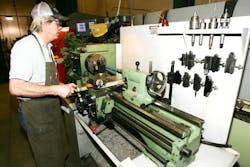Manager: Jeff Wessels, maintenance division chief
Company: Ryder System Inc.
Operation: Installation Materiel Maintenance Activity (IMMA) Allied Trades team, Fort McCoy, WI
PROBLEM:
When you’re tasked to help provide logistics support to any number of mechanized reserve and active-duty U.S. Army units based in Wisconsin, not to mention state and federal fleet equipment in the local area as well, you’ll see ticklish maintenance problems from time to time.
That’s in no small part due to the need to keep older equipment (items such as front-end wheel loaders and trucks) up and running. Army units get the latest and greatest in terms of tanks and other combat vehicles, but shelling out $150,000 to $500,000 for a brand-new front-end loader that gets used infrequently isn’t usually considered the best use of military dollars. And the same goes for state and federal fleets.
Finding replacement parts for older vehicles, especially construction-related equipment, isn’t easy and neither is painting it, a task that often can’t be outsourced without a good bit of delay.
SOLUTION:
For Jeff Wessels, solving those issues boiled down to three simple words: do it yourself.
The four members of the IMMA team—all private-sector personnel contracted from Accent Controls Inc. (ACI), an engineering firm headquartered out of Kansas City, MO—are steeped in the art of welding, machining, and painting to keep older equipment in a “like-new” condition.
“Machining might include making drain fittings or completing thread repair on a bolt or specialty item,” Doyle Docken, a machinist with 36 years of experience, says. “We complete fabrication of many different things in here. Essentially, we have to be able to repair nearly anything made from metal.”
“If we need to make a part to be welded on to a [front-end] loader or other piece of equipment, for example, we get together, get our dimensions, make the part, and machine out the holes and platforms for the part. I weld them and then we go from there,” Dan Kast, a welder with ACI, explains. “Sometimes you might get blueprints for a part, but a lot of it is figuring out how the part is going to work, how you need to make it, and then you fabricate the item you need.”
It then needs to be painted—and this is where David Johnson puts his skills to work. “We’ll take a vehicle or a piece of equipment and first use a water blaster that has close to 40,000 psi to remove all the paint,” he says. “Then we move it from there to a paint booth, where we prep it."
Johnson, who has more than 30 years of painting experience, said an environmentally friendly, water-based paint is used in conjunction with a new “curing booth” that cuts drying time for freshly painted vehicles from three days to just three hours at the base. “We can paint anything from big to small,” he adds. “We could fit a crane in the paint booth if we needed to. We can essentially paint anything in the Army inventory.”
Wessels says that’s why such “skilled labor” is “a necessary” link in the chain of support that is crucial to the success of IMMA and the equipment it supports. “They help repair the things that keep our operations going at Fort McCoy,” he emphasizes.
About the Author
Sean Kilcarr
Editor in Chief
Sean Kilcarr is a former longtime FleetOwner senior editor who wrote for the publication from 2000 to 2018. He served as editor-in-chief from 2017 to 2018.
